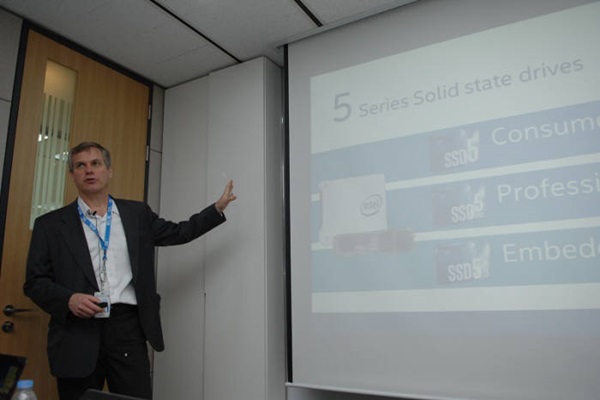Intel Commercializes Its First SSD with 3D-Chip
“We are going to directly produce our 3D NAND-Flash Chips at factories in Dalian, China starting from end of this year and these chips will be used for Intel’s SSD (Solid-State Drive). Although we had co-operated these factories with Micron in the past, we have established our own production system. This can be seen as Intel’s way of expressing its strong intention in going after Flash-Memory markets.” said David Lundell who is the director of Intel’s client SSD strategic planning and marketing.
Intel has challenged Samsung Electronics in 3D NAND-Flash. Intel held a press conference in Seoul on the 15th and introduced new SSD with its first 3D NAND-Flash.
David Lundell, who is the director of Intel’s client SSD strategic planning and marketing, held a briefing session by visiting Seoul directly. He visited South Korea right after attending a developer forum that was held in China on the 13th and 14th. Experts believe that Intel is challenging Samsung Electronics due to a fact that Intel is introducing its new technologies and new products in South Korea, where Samsung Electronics that is the top business in NAND-Flash is from.
Intel had been taking passive approach in memory field after giving up D-RAM business in 1985. However it formerly announced last year that it would change its system semiconductor factories in Dalian into NAND-Flash production factories by investing $5.39 billion (6.2 trillion KRW). This show its intention in entering memory market once again. It is predicted that 3D NAND-Flash that was co-developed with Micron will be produced at these factories and 3D Cross-Point Memories will be produced here later.

“Although SSD only takes up about 10 to 20% in all storage markets, it is predicted that it will quickly grow in the future.” said Director Lundell. “Intel came to a conclusion that it should also grow this business.”
He also introduced 3D NAND-Flash that uses FG (Floating Gate) method that is co-developed with Micron. FG method is a technology that used to be used for 2D NAND-Flash. “We increased efficiency in cost by using FG method that has its performance verified for last 25 years.” said Director Lundell.
Samsung Electronics uses CTF (Charge Trap Flash) technology, which is an evolved technology of FG, for 3D NAND-Flash. CTF is a technology that reduces interference phenomenon within cells and allows electric charge to be stored in an insulator. On the other hand, interference phenomenon becomes worse for FG method as memory cells become smaller and cells can lose their functions when electric charge is taken out and inserted back in often.
To a question regarding comparison of age and reliability of SSDs that have Intel’s 3D NAND-Flash Chips and CTF Chips, Intel replied back by saying it does not have clear answers.
“We are going to supply SSD Optane sample that has 3D Cross-Point Memory to our customers at the end of this year.” said Director Lundell. “Although 3D Cross-Point Memory is slower than D-RAM, it will be able to create variety of new markets such as high-performance SSD and low-speed D-RAM as it is faster than NAND-Flash and is non-volatile.”
According to a market research company called IHS, Samsung Electronics maintained its top position in SSD market by making $5.4 billion (about 6.21 trillion KRW) in sales and 38% in shares. On the other hand, Intel made $1.934 billion (about 2.2 trillion KRW) in sales and 14% in shares. Although Intel was the top company in enterprise SSD market such as server until 2014, it gave up its position to Samsung Electronics after being behind by narrow margin.
Staff Reporter Han, Juyeop | powerusr@etnews.com